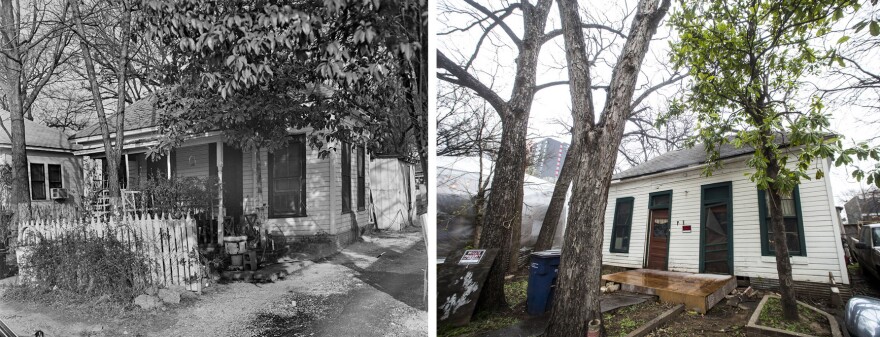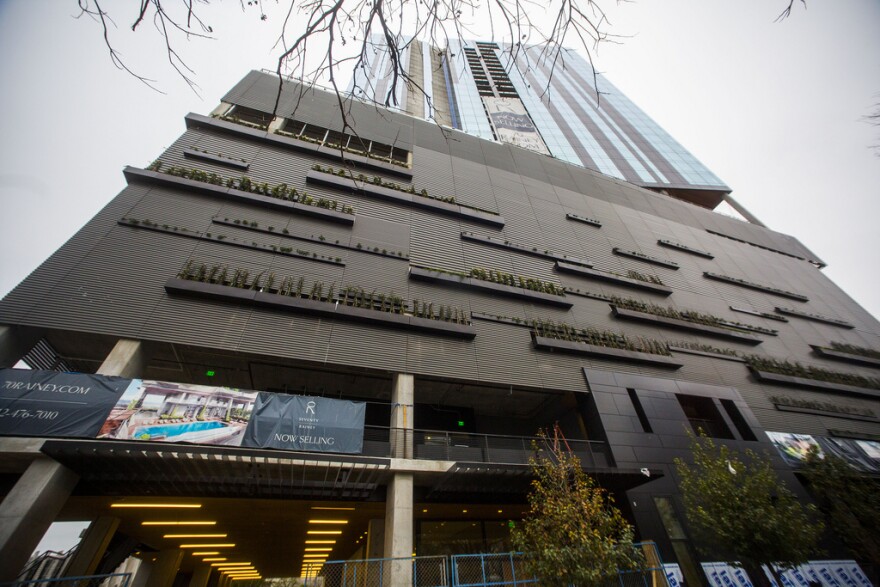This story was originally published on February 14, 2019.
Nearly 30 people leaned against the railing on the second floor of a bar made out of shipyard containers. It was a warm Saturday night in September. Down the street, people sat on the front porch of Icenhauer’s, which pours grilled-pineapple-infused tequila.
This is Rainey Street in downtown Austin. If you've never been there, here are some words to describe it: “[a] grown-up frat row.”

It wasn’t always like this.
“It was a pretty, pretty quiet neighborhood,” said Bobby Velasquez, who moved into a house on Rainey in the 1970s.
Over the next few decades, downtown and real estate interests converged on Rainey: The city built a new convention center down the road, and City Council members changed zoning rules so businesses could open on the street.
Velasquez sold the two homes he owned on Rainey in 2010. Other families on the street did the same. A handful still own property, but they rent it to bars and food trucks.
Only one person stayed.
'The Last Of The Mexican-Americans'
I first met John Contreras last April when a KUT listener asked this question for our ATXplained series: “Where did the former residents of Rainey Street's single-family homes go after their homes were bought and turned into bars/condos?”
I went door to door, trying to find anyone who still lived in the houses on Rainey. Contreras, who is in his 60s, opened his door and said he’d be OK with an interview, but could I come back?
RELATED | Subscribe to the ATXplained podcast
I did. For weeks. I’d knock. He wouldn’t answer. I’d leave a note or business card. He would get back to me, via voicemail.
“Hi Audrey, this is John Contreras. 71 Rainey St. The last of the Mexican-Americans or the last of the Mohicans. Probably both,” Contreras said, laughing, in his first message.
“I don’t know if I’ll ever talk to you again. Frankly, I don’t really care."
Over the past 10 months, Contreras has left me roughly three dozen voicemails – mostly late at night, mostly on my work phone. From these messages, you can imagine what life is like for the "last man" on Rainey.
“I guess I’m somewhat compelled to speak to somebody,” he said in a message last weekend.
'Why Should I Leave?'
According to property records, the white wooden home with the green trim at 71 Rainey was built in 1910. Contreras’ grandparents bought it in the 1940s, and he lived there for a period when his mom was sick with tuberculosis. She died at 34.

“It always hurt my heart, because she would be sent off to sanatoriums,” Contreras said. “My mom suffered a whole lot.”
Contreras moved into the house in 1989. Around that time, the City of Austin started talks about building a convention center at Second and Trinity streets, and residents began to sense downtown was encroaching on their neighborhood.
RELATED | Join the ATXplained Facebook group
Velasquez said he gathered neighbors to make a plan. He got in touch with real estate developers, trying to ensure residents could benefit from new development. It was a delicate line to walk. Neighbors accused him of trying to make a quick buck.
“Well, I said, ‘I’m not in it to make money,’” said Velasquez, who now lives in Del Valle. “'I’m in it to get out of here, because I can’t afford my taxes no more.’”
Decades passed before much changed. Then, in 2005, some residents got what they were looking for: The City Council voted to rezone the street so the single-story homes that defined the area could open as businesses.
Families sold their homes and left. Contreras decided to stay put.
“Most people think I'm crazy. But am I? Come on. So many people left for peanuts,” he said in a voicemail from April. “Why should I leave? Just to appease the white people? No.”
'Been A Musician All My Life'
Contreras talks a lot about music in his voicemails.
He played guitar in bands around Austin when he was a teenager, eventually joining the Tejano group Ruben Ramos and the Mexican Revolution when he was 17 years old.

Contreras said touring and playing shows primed him for the hours of Rainey Street.
“A lot of times, I have a hard time sleeping," he said. "No, it's not the music! I'm a musician. I'm an ex-musician. Been a musician all my life.”
In some voicemails, he plays me music – Roy Buchanan, Thelonious Monk, Wes Montgomery.
“My favorite guitar player, my most favorite guitar player, was Wes Montgomery,” Contreras said in a voicemail left in December. “Because he was smart and he could portray in chords, oh, so much.”
While Contreras said he doesn’t mind the hours that partygoers on Rainey keep, he does mind the drunk people who stumble into his yard. Sometimes, he said, they tilt their bodies to mock the slant of his aging home.
“I live here. This is my house. You can’t just go walking around my yard,” Contreras said. “They don’t know or they don’t care that I live here.”
But Contreras is determined to stay put.
“Living here, it’s not easy. Never has been. But I guess it’s a self-determination thing.”
'This Is My House'
In December, the Austin Code Department sent Contreras a letter saying his home was “unsafe.” According to a copy of that letter, unless he replaces his roof and makes other repairs, the city could fine him – or even remove him from his home.
That's left Contreras feeling unmoored.
“This is my house,” he said in a voicemail left in January. “After a while, I guess, with age you just want to live out your life in a place you call home.”
Since receiving the letter from the city, Contreras has started calling me more, sometimes leaving six voicemails in one night: 7:21 p.m., 7:27 p.m., 11:40 p.m., 12:51 a.m., 12:57 a.m., 1:16 a.m. He says he's starting to feel the pressure to leave his home.
“I’m getting ready to leave this place. Maybe I’ll make some money out of it, maybe I won’t. But I am the last of the Mohicans. And, I guess, I’m scared, you know?” said Contreras, his voice breaking.
A 34-story condominium building recently went up across from his house.

“It’s not like Joe Blow, who rents a house and moves on, or Joe Blow that buys a house and moves on,” Contreras said in a voicemail last month. “It’s more internal.”
He added: “Hopefully you’re still there.”
“I always feel melancholy when I [think about leaving] this place. This is my home. Not only mine but mine in spirit. Hopefully you’ll understand. I’m saying this because maybe –”
Then the phone line cut out.
Update: In late 2019, after this story was published, the last house on Rainey Street was purchased by Austin bar owner Bob Woody. The house was cleared for demolition in 2021 due to hazardous interior conditions.
_









